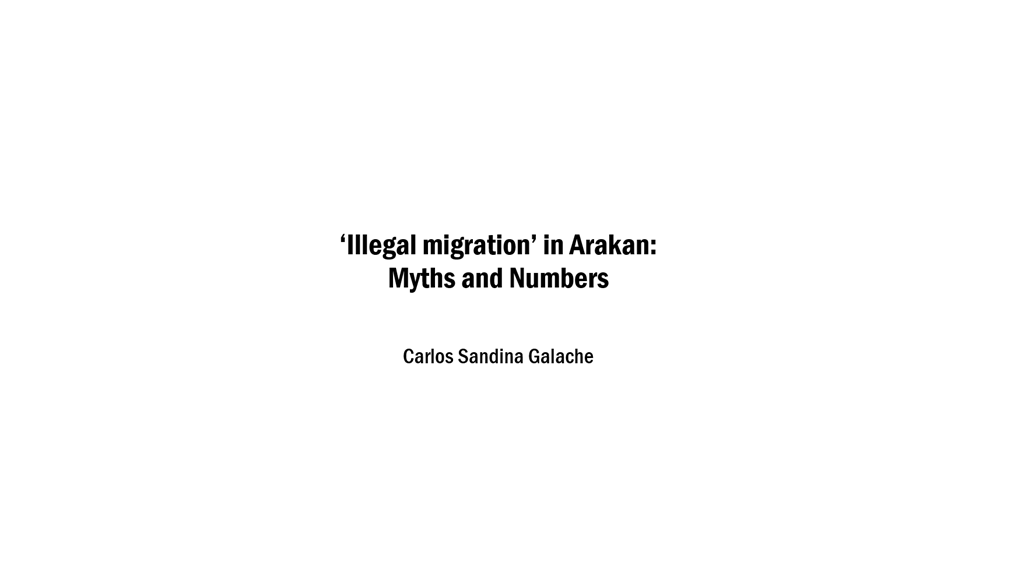
‘Illegal migration’ in Arakan: Myths and Numbers
Category: Reports Publisher: Carlos Sandina Galache Published: 16 August 2018 Tags: Arakan | Bangladesh | Myanmar | Rakhine | Rohingya | DownloadOne of the rationales underlying the persecution of the Rohingya by the Burmese state is that they are branded “illegal immigrants from Bangladesh”, having flooded Rakhine State (formerly known, and referred to here, as Arakan State) over the last century.
But how valid are such claims in the face of available evidence? The border between Bangladesh and Burma is extremely porous and has been poorly guarded on both sides for long stretches of time; smuggling of all kind of goods, including narcotics, is a common feature there, and often happens with the connivance of corrupt of officials. Moreover, the grip of the Burmese state in border areas is very tenuous, and Northern Arakan is no exception.
Nobody, however, has provided any evidence of massive waves of “illegal Bengalis”. Nevertheless, the government and institutions linked to it have repeated such claims over and over again, and they are believed by many Burmese. In 1965, Ne Win visited Pakistan, and the West German ambassador reported that discussions took place about “the problem of the roughly 250,000 Moslems resident in the Province of Arakan whose nationality is unclarified because the Burmese regime regards them as illegal immigrants from East Pakistan.”
This figure was literally doubled in a paper published as recently as 2018 by the Myanmar Institute of Strategic and International Studies (Myanmar-ISIS), a government think tank founded in 1992 by the military junta then ruling the country. The paper asserts that “in 1971, there were around half a million war refugees who fled into Myanmar […] to escape the violence of the Bangladeshi war of independence.”
Myanmar-ISIS gives two sources for such an extraordinary assertion: a book written by Moshe Yegar, a former Israeli diplomat, and a conversation that the British and Bangladeshi ambassadors in Rangoon maintained in 1975, as recounted by the British diplomat. But Moshe Yegar merely wrote that “an undetermined number of Bengalis who were opposed to the cessation of Bangladesh from Pakistan fled to Arakan. Subsequently almost 17,000 Bengalis returned though the number that remained in Arakan continues to be unknown.”
And in the conversation between the two diplomats, the British ambassador recounts that his Bangladeshi counterpart “admitted that there were upward of ½ million Bangalee [sic] trespassers in Arakan whom the Burmese had some right to eject”. The problem is that nowhere is given give any indication of what the Bangladeshi diplomat meant by “Bangalee trespassers”.
In a context in which young modern nation-states had been built on the basis of ethno-religious identities—as it was the case of the partition on India and Pakistan and the subsequent partition between West Pakistan and East Pakistan which generated Bangladesh—the Bangladeshi ambassador could have meant that the “Bengalis” didn’t belong to Arakan State as a consequence of their ethno-religious identity: in short, that many of them had trespassed during colonial times. There is no reason to believe he meant that half a million Bengalis migrated to Arakan after Burmese independence, let alone after the Liberation War of Bangladesh in 1971.
And whatever he meant, there is no reason to believe that he was right. His credibility is seriously put in doubt by no other than the British ambassador himself, who at the end of the report asserts: “I do not regard [the Bangladeshi ambassador] Mr Kaiser as an entirely reliable source of evidence. I have found his views in the past highly subjective and sensational.” Such is the flimsy “evidence” for the invasion of “illegal immigrants” narrative. It is important to recall here that, in the strict sense, “illegal immigration” only refers to such migration that may have occurred after Burma attained independence in 1948. According to colonial laws, migration from any part of India to Burma was perfectly legal. And no law enacted after independence by the Burmese government, not even the infamous 1982 Citizenship Law, has made immigration during the colonial period retroactively illegal. Therefore, I will focus on the period after independence, not on the heated debate on the term “Rohingya”, as I have done already in New Mandala, or migration waves during colonial times.
In order to ascertain the extent of “illegal immigration” from East Pakistan/Bangladesh, we need to take a look at censuses. A comparison between the 1931 census, the last conducted by the British in Burma whose full results have been preserved, and the 1983 and 2014 censuses, carried out by the Burmese government, should throw some light on the question. It is a task complicated by the fact that the ethnic, and national categories employed in these censuses are far from consistent. Comparing ethnic categories is almost impossible, given how arbitrary such classifications were both under the colonial period and after independence. For instance, in the 1983 Census, most Muslims in Arakan were incongruously classified as “Bangladeshis”, that is, as citizens of a nation-state which at that time had only existed for 12 years.
Back

